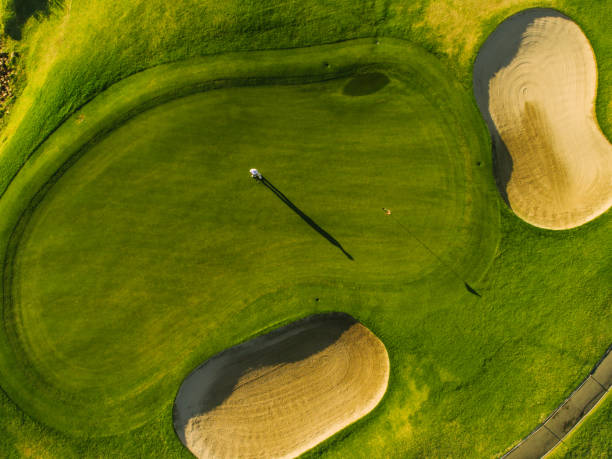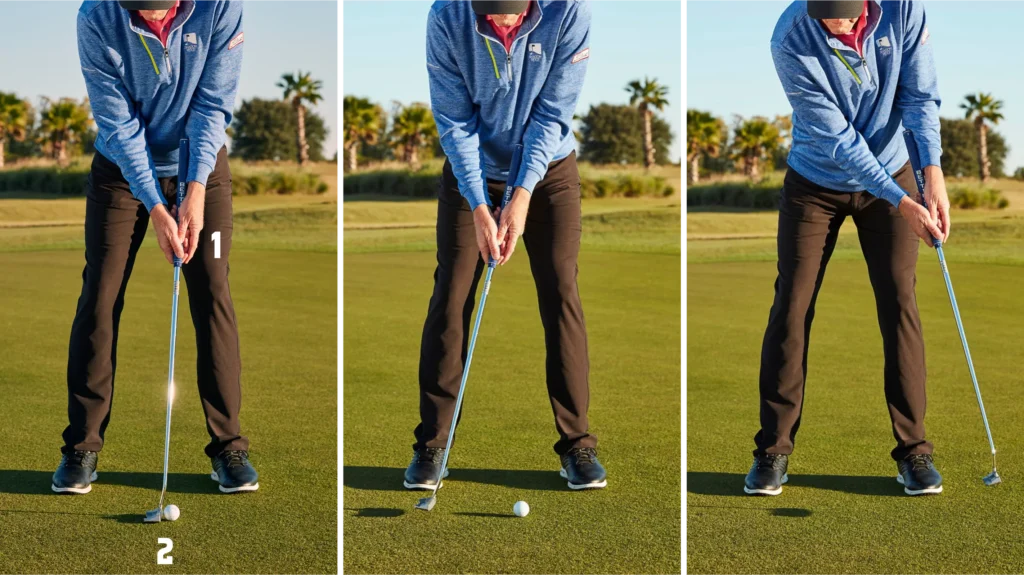How to Putt Like a Pro: A Comprehensive Guide

In golf, here every stroke counts, and none more so than the putt. Putting is the heartbeat of the game, strokes that make all the difference in lowering your score.
In this guide, we’ll explore the fundamentals of how to putt, from reading the green to developing a silky stroke. Whether you’re a seasoned golfer or just getting started, we’re here to help you sink more putts and enjoy the game even more.
Learn How to Putt!
Understanding the Basics

Getting Friendly with the Putting Green
Okay, folks, before we dive into the nitty-gritty of putting, let’s get to know the stage – the putting green.
- The Green Surface – This is where the magic happens! It’s like a finely groomed carpet, smooth and lush. But watch out, it can be tricky with its slopes and contours.
- The Hole (Cup) – Your ultimate goal is to sink that ball in there. BUT trust me, it’s not as easy as it looks.
- The Putting Green’s Surrounding Areas – Keep an eye on the rough, bunkers, and other hazards around. They can be your worst enemies if you’re not careful.
Picking Your Putter
Choosing the right putter is like choosing the right tool for the job. Here are your options:
- Blade Putters – These look like traditional putters with a thin, straight blade. They’re great for precision, like a surgeon’s scalpel.
- Mallet Putters – Imagine a futuristic spaceship at the end of your stick. Mallet putters have a larger, more forgiving head, making them excellent for beginners.
- Putter Length and Design – Your putter’s length and design matter. Make sure it feels comfortable in your hands and suits your putting style.
Grip it and Rip it… Softly
Now, let’s talk about how you hold that putter and stand over the ball.
- The Grip – It’s like shaking hands with your club. You can interlock your fingers, overlap them, or use the ten-finger grip. Find what feels right for you.
- Addressing the Ball – This is where you set up your shot. Get your feet aligned, position the ball just right, and stand with good posture. No slouching, folks!
Remember, we’re here to have fun, so don’t stress too much. Get comfortable with your putter, and let’s roll on to the next part.
The Putting Stroke

Swing Like a Pendulum
Okay, folks, let’s talk about the swing – not the dancing kind, but the golfing kind!
The Pendulum Motion – Imagine a grandpa’s old clock ticking back and forth. That’s the motion you want for your putting stroke – smooth and even, like stirring honey into your tea.
Consistency is Key
Why does your buddy keep sinking those putts? It’s probably because they’ve got a consistent stroke!
The Importance of a Consistent Stroke – Every putt you make should feel like déjà vu. Consistency in your stroke means you can rely on muscle memory, and that’s your ticket to putting success.
Smooth Like Butter
Now, how do you get that silky-smooth, rhythmic stroke? It’s all about practice.
How to Develop a Smooth, Rhythmic Stroke – Think of your favorite song’s beat. Your putting stroke should have a rhythm, too. It’s all about finding your groove.
- Practice Putting Drills for Stroke Consistency – Try the “gate drill.” Set up two tees just wider than your putter head’s width. Practice stroking the ball through the gate without touching the tees. It’ll help you keep that stroke on point. It’s a great putting drill.
Remember, Rome wasn’t built in a day, and neither is a perfect putting stroke. Practice, practice, and practice some more, and soon you’ll be stroking those putts like a pro!
Reading Greens
Navigating the Break and Slope
Alright, let’s talk about understanding the mysteries of greens. They’re like nature’s rollercoaster.
Understanding the Break and Slope – Greens are not flat, folks. They have slopes and contours, and you need to figure out how the ball will curve. It’s like predicting where a marble will roll on a wavy table.
Sherlock Holmes on the Green
Investigate the entire green, stand in front, behind and one the side of the hole.
Techniques for Reading Greens Effectively – These are your secret tools to unveil the green’s secrets:
- Analyzing the Terrain – Look for clues like subtle slopes, bumps, and even the direction of grass growth. Nature leaves breadcrumbs everywhere!
- Using Your Feet and Eyes – Step on the green (carefully!) and get a feel for it. Your feet are like sensors. Look at the straight line from behind the ball and the hole. Trust your eyes to spot the puzzle pieces.
The Need for Speed
Ever wonder why your ball doesn’t stop where you want it to? That’s all about green speed!
Tips for Interpreting Green Speed – Sometimes, greens are speedy like a racecar, and sometimes they’re sluggish like a sloth. Here’s how to handle different situations:
- Uphill and Downhill Putts – Uphill putts slow the ball down, so give it a bit more oomph. Downhill putts are like a slippery slide, so be gentle with your stroke. Adjust your touch accordingly.
Remember, reading greens is part science, part art, and a lot of experience. The more you practice, the better you’ll become at unraveling the green’s mysteries!
Aim and Alignment: Hitting the Bullseye
Choosing Your Target Line
Alright, time to aim for success! You need a plan, and that starts with picking a target line.
Picking a Target Line – Think of this like aiming at the bullseye in darts. Choose a spot on your intended path where you want your ball to roll over. It could be a brown spot, a blade of grass, or a subtle slope. Make it your North Star.
Getting Your Act Together
Now that you’ve picked your target, you need to line up your body and putter. It’s like setting up a bowling shot – precision is key!
Properly Aligning Your Body and Putter Face – Here’s how to do it right:
- Stand parallel to your target line. Imagine railroad tracks; your feet are one track, and your putter face is the other. Keep them in sync.
- Ensure your putter face is square to your target line. You don’t want it pointing somewhere else; that’s like a compass gone haywire.
See it, Believe it
Ever heard the saying “visualize success”? It’s time to put that into action on the green!
Visualizing the Ideal Putt – Close your eyes for a moment and picture the ball rolling smoothly along your chosen target line, right into the cup. Believe in your putt like it’s already happened. Confidence is your secret weapon.
Remember, putting isn’t just about mechanics; it’s also about mental focus and believing in your ability to sink that putt. Aim, align, and visualize your way to putting perfection!

Pre-Putt Routine: Your Mental Game Matters
Get into the Routine Habit
Before you start your putt, it’s time to establish a rock-solid pre-putt routine:
Establishing a Consistent Routine – Think of this like your pre-game ritual. Find a sequence that works for you and stick to it. Consistency helps calm those pre-putt jitters.
Picture Perfect
Now, let’s add a pinch of magic to your routine – visualization:
Visualizing the Putt – Close your eyes for a moment and see the putt in your mind. Picture the ball rolling smoothly along your chosen line, dropping into the cup with a satisfying plop. Believe it, feel it – your mind is a powerful ally.
Battling the Butterflies
But what about those pesky pre-putt nerves? We all get them. It’s time to tame the butterflies:
Managing Pre-Putt Nerves and Anxiety – Take a deep breath, literally. Inhale calmness, exhale tension. Remind yourself that you’ve practiced, you’ve got this, and it’s just another putt. Embrace the excitement; it’s what makes golf thrilling!
Remember, your pre-putt routine is like your secret weapon. It not only prepares you physically but mentally as well. Stick to it, visualize success, and conquer those nerves – you’re on your way to putting like a pro!
Speed Control: Don’t Let Your Putts Roll Away
The Need for Speed
Before you send that ball on its journey, you’ve got to master speed control. Here’s what you need to know:
Factors Affecting Putt Speed – Think of your putt as a car on the highway; the speedometer matters.
- Green Conditions – Greens can be fast or slow depending on various factors, like recent maintenance, weather, and grass type. Pay attention to these conditions; they’re your traffic signs.
- Uphill and Downhill Putts – Just like driving uphill slows you down and downhill speeds you up, the same goes for putting. Uphill putts need a bit more gas, while downhill putts require a gentle touch.
Drills to Get the Feel
Now that you understand the speedometer, it’s time to practice controlling it.
Drills for Improving Speed Control – These drills are like your driving lessons for the putting green:
- Lag Putting Practice – Try putting from different distances and focus on getting the ball close to the hole without necessarily sinking it. This builds your feel for different green speeds.
- Distance Control Drills – Set up markers at various distances and practice getting the ball to stop near them. It’s like practicing your free throw in basketball.
Consistency is the Name of the Game
Remember, it’s not just about hitting the right speed; it’s about doing it consistently.
The Importance of a Consistent Pace – Picture a metronome ticking at the same tempo. Your putting should have that same rhythm. Consistency in pace makes your putts predictable and easier to control.
So, next time you’re on the green, pay attention to speed. It’s like the gas pedal of your putt-mobile – sometimes you rev it up, and other times you ease off. Master it, and you’re on the road to putting success!
Practicing Your Putting: The Road to Perfection
Why Practice Makes Perfect
Before we get into the fun stuff, let’s talk about why putting practice is like gold dust for your game:
Importance of Regular Practice – Just like learning to ride a bike, putting needs repetition. Regular practice builds muscle memory, and that’s your secret weapon on the green.
Fun and Games on the Putting Green
Now, let’s get into some drills and exercises that will level up your putting game:
- Distance Control Drills – Imagine you’re bowling, but with a putter. Set up markers at different distances from the hole and try to get as close as possible. This helps you nail those tricky long putts.
- Gate Drills for Accuracy – Place two tees slightly wider than your putter head on your target line. Your mission: roll the ball through without touching them. This is like threading a needle on the green.
- Lag Putting Exercises – Find a practice green and practice putting from various distances. The goal isn’t to sink it but to get the golf ball close to the hole. This is like practicing your three-pointers in basketball.
Keep Tabs on Your Progress
You’re putting in the work; now let’s measure those gains:
- Tracking Your Progress – Keep a putting journal. Write down your practice sessions, how many putts you make, and any areas where you struggle. This helps you identify your strengths and weaknesses.
Remember, practice isn’t just about quantity; it’s about quality. Focus on refining your technique and learning from every putt. Keep at it, and you’ll be draining putts like a pro in no time!
Troubleshooting Common Putting Problems: Navigating the Bumps on the Green
Putting isn’t all sunshine and rainbows. Sometimes, you’ll face challenges, but fear not – we’ve got solutions.
Banishing the Yips
First up, those dreaded yips – the golfer’s nightmare:
Dealing with the Yips – It’s like a hiccup in your putting stroke. To combat this pesky problem:
- Try a different putter grip or putter style. Sometimes, a change can work wonders.
- Practice short putts with complete focus. Build your confidence one putt at a time.
- Take a deep breath and visualize a smooth putt. Remember, it’s not about forcing it; it’s about trusting your stroke.
Related article: 7 Best Golf Grips 2023: Ranked and Reviewed
Straighten Up Your Alignment
Ever feel like your putts go everywhere except where you want them to? Alignment issues might be to blame:
Overcoming Alignment Issues – To get back on track:
- Use alignment aids like alignment sticks or a trusted friend’s eyes to help you aim correctly.
- Focus on your setup – ensure your feet, hips, and shoulders are parallel to your target line.
- Practice your alignment as part of your pre-putt routine. Consistency is key!
Pressure Putts: Embrace the Heat
Pressure putts can make even the pros break a sweat. But don’t let them get to you:
Managing Pressure Putts – The key is to stay cool under pressure:
- Breathe deeply and slowly. Calm your nerves and regain focus.
- Trust your practice. Remember all those hours you spent perfecting your stroke.
- Pick a small, specific target on the hole, like a blade of grass. This narrows your focus and increases your chances of success.
Putting under pressure is all about mindset. Embrace the challenge, and remember, even the best golfers miss sometimes. It’s part of the game.
So, whether you’re battling the yips, alignment issues, or the pressure of the moment, there’s a solution. Stay patient, stay persistent, and keep working on your game. You’ve got this!
On-Course Strategies: Navigating the Greens Like a Pro
Now that you’ve honed your putting skills, it’s time to tackle the real deal – the golf course.
Course Management for Putting Success
Course Management for Putting Success – It’s like chess on the greens. Here’s how to master it:
- Read the Green: Before you putt, study the green. Take note of slopes, breaks, and any hazards in your path. This knowledge will guide your stroke.
- Choose Your Putter: Based on green speed and distance, decide which putter suits the shot best. Blade or mallet? Long or short?
- Plan Your Approach: Position yourself for an uphill putt whenever possible. These are generally easier to control.
Green Variety: Adapting to the Changing Tides
Handling Different Green Types and Speeds – Not all greens are created equal. Here’s how to adapt:
- Fast Greens: On lightning-quick greens, putt with a softer touch. Pay attention to the slope; it can make the ball go wild.
- Slow Greens: On slower greens, give your putts a bit more oomph. Your usual stroke might not cut it.
- Bumpy Greens: Some greens can be rough. Brace yourself for unpredictability and don’t be discouraged by a few bounces.
Staying Zen on the Course
Maintaining Focus During a Round – The mental game is just as important as the physical one:
- Stay in the Present: Focus on one shot at a time. Don’t dwell on past misses or future putts. Each putt is its own story.
- Breathe Deeply: Take calming breaths to center yourself. It’s amazing what a few deep breaths can do for your nerves.
- Positive Self-talk: Replace negative thoughts with positive affirmations. Tell yourself you’ve got this and believe it.
Remember, golf is as much about the mind as it is about the swing. Stay sharp, adapt to the course, and maintain your focus – you’re on your way to putting success on the real battleground!
Wrap-Up.
There you have it, our guide on how to putt. As you venture onto the greens, remember that putting is where the game is shaped.
Practice consistently, stay mentally sharp, and apply what you’ve learned. Your journey to putting excellence is underway.
Confidence in your stroke, adaptability on the course, and a passion for improvement will carry you far. Embrace the challenges and savor the victories, no matter how small.
So, step onto the green with purpose, align your putter, and envision success. With each putt, you’re one step closer to the thrill of sinking it in the cup. Most importantly, enjoy the game.